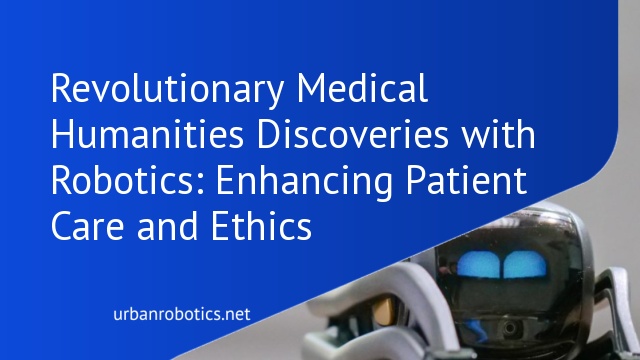The Intersection of Medical Humanities and Robotics
Medical humanities and robotics aim to integrate humanistic perspectives with technological advancements. We see these intersections in patient care, ethics, and enriched clinical experiences.
Patient Care and Robotics
Robotic systems, like AI-guided surgical robots, enhance precision and reduce recovery times. In palliative care, robots provide consistent emotional support. For example, the PARO therapeutic robot offers comfort to dementia patients.
Ethics in Robotic Healthcare
Robotics raise ethical questions about autonomy and consent. We must ensure patients understand robotic interventions and maintain control over their treatment. Balancing technology and human touch remains crucial.
Clinical Experience Enrichment
Medical training benefits from robotic simulations. These tools enable practitioners to refine their skills without patient risk. Additionally, robotic-assisted art therapy helps patients express emotions creatively, enhancing their overall treatment experience.
Robotic advancements redefine the boundaries of medical humanities by merging empathy and innovation for comprehensive healthcare.
Historical Background of Robotics in Medicine
Robotics in medicine has evolved over decades, significantly impacting medical humanities. Pioneering innovations and milestones have shaped today’s advanced healthcare systems.
Early Technological Innovations
Early technological innovations laid the foundation for modern medical robotics. The 1980s saw the introduction of PUMA 560, a robotic arm used in neurosurgical biopsies. By the 1990s, AESOP, a voice-activated endoscope, improved laparoscopic procedures. These advances demonstrated the potential of robotics in enhancing surgical precision and efficiency, guiding subsequent developments in the field.
Milestones in Robotic-Assisted Surgeries
Several milestones mark the progress of robotic-assisted surgeries. In 2000, the FDA approved the da Vinci Surgical System, revolutionizing minimally invasive surgeries with its enhanced dexterity and 3D visualization. By 2010, over 200,000 robotic-assisted procedures were performed annually worldwide. Such milestones have solidified the critical role of robotics in modern medicine, ensuring improved patient outcomes and setting the stage for future innovations.
Key Discoveries in Medical Humanities with Robotics
Ethical Considerations
Robotics in healthcare have introduced several ethical considerations. For instance, questions about patient consent and data privacy arise when robots collect and use sensitive patient information. Ensuring that robotic systems respect patient autonomy and privacy remains paramount. The integration of AI in decision-making processes in care and surgery challenges traditional notions of medical responsibility. We must address these concerns to develop ethical frameworks that support both technological advancements and patient rights in the healthcare system.
Human-Computer Interaction
Human-computer interaction (HCI) in medical robotics plays a crucial role in effective healthcare delivery. The design of user-friendly robotic interfaces ensures that healthcare providers can operate these systems efficiently and safely. Advanced HCI techniques enhance the interaction between humans and robots, making it more intuitive and seamless. For example, haptic feedback systems allow surgeons to sense resistance during robotic surgeries, improving precision. Prioritizing ergonomic and functional designs in HCI helps us maximize the benefits of robotics while minimizing potential errors.
Psychological Impact on Patients and Healthcare Providers
The introduction of robotics in medical settings significantly impacts patients and healthcare providers psychologically. Patients may initially feel anxious about receiving care from robots, but studies show that familiarity with robotic systems can reduce anxiety over time. Additionally, robotic companions like PARO, a therapeutic robot, offer emotional support, enhancing patient comfort. For healthcare providers, robotics can reduce the physical strain of repetitive tasks, leading to improved job satisfaction. Acknowledging and addressing these psychological aspects is crucial for the successful integration of robotics in healthcare.
Case Studies Highlighting Discoveries
Discoveries in medical humanities through robotics provide insightful stories and learning experiences. Robotic innovations continually reshape patient care and clinical practices.
Success Stories in Robotic-Assisted Therapy
Success stories in robotic-assisted therapy highlight advancements in patient rehabilitation. For example, robotics like the Lokomat system help spinal cord injury patients regain mobility through guided walking therapy. Interactive therapy robots, such as NAO, encourage children with autism to improve social skills via engaging sessions. These case studies emphasize how robotics enhance therapeutic outcomes and patient engagement.
Challenges and Learning Experiences
Integrating robotics in medical humanities presents challenges and learning experiences. Technical malfunctions in robotic systems sometimes lead to therapy interruptions, highlighting the need for reliable engineering. Ethical dilemmas around patient data privacy and consent arise with more sophisticated robots, necessitating stricter protocols. By addressing these issues, we refine strategies to incorporate robotics in healthcare effectively.
Future Prospects in Medical Humanities and Robotics
Innovations in robotics continually shape the medical humanities by enhancing patient care and ethical practices. These advancements open new avenues for discoveries and applications.
Emerging Technologies
Robotic technologies like AI-integrated diagnostics and nano-robots hold promise. AI improves predictive analytics, helping clinical decision-making. Nano-robots perform precise tasks at the cellular level, revolutionizing treatments. Emotional support robots evolve to offer better companionship and mental health support. With these technologies, patient care becomes more nuanced, ensuring personalized treatment.
Predictions for Future Discoveries
We anticipate breakthroughs in robotics to address complex medical challenges. Robotic prosthetics might offer enhanced mobility and sensory feedback, improving life quality for amputees. AI-driven robots could advance patient rehabilitation, offering tailored exercises and real-time feedback. Future discoveries could also refine ethical standards, ensuring trust and collaboration between humans and machines. With ongoing research, the synergy between medical humanities and robotics promises to transform healthcare.
Conclusion
The intersection of robotics and medical humanities offers a promising future for healthcare. As we continue to integrate AI and advanced robotics into medical practices, we’re not only improving surgical precision and diagnostics but also enhancing patient care and ethical standards. The potential for breakthroughs in areas like robotic prosthetics and AI-driven rehabilitation is immense. By embracing these innovations, we can reshape patient experiences and therapeutic outcomes, paving the way for a more advanced and compassionate healthcare system.





